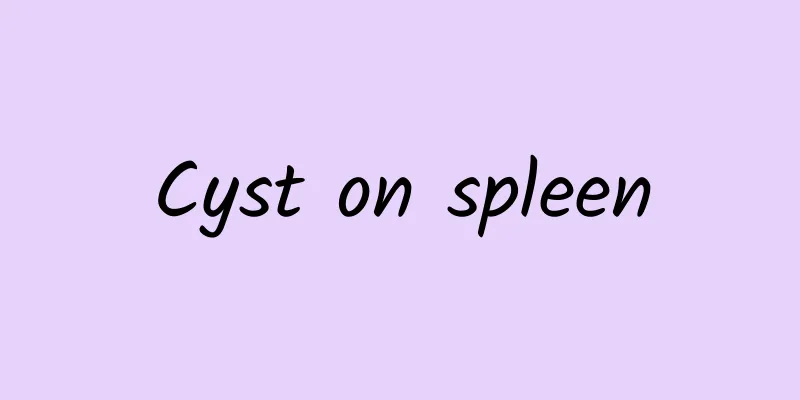Cyst on spleen

|
The main reason for cysts on the spleen is the appearance of tumor-like cystic lesions in the skin tissue. Clinically, the main types of cysts are parasitic cysts and non-parasitic cysts, which are generally more common in young and middle-aged people. Small cysts have relatively mild clinical symptoms and can be detected through B-ultrasound examination. However, if the cyst is relatively large, it often compresses the adjacent tissues and organs, and the symptoms will be more obvious. Let’s take a look at this aspect below. Causes of cysts on the spleen 1. Parasitic cyst infection is composed of hydatid cysts of the genus Echinococcus. The larvae enter the spleen through the blood and develop into parasitic cysts. The inner wall of the cyst is not lined with epithelium. The cyst contains parasite bodies or eggs and necrotic tissue. There may be splenic hydatid cysts, which often coexist with hepatic and pulmonary echinococcosis. It can be seen in livestock breeding areas in northern China. 2. Non-parasitic cysts include true cysts and pseudocysts. (1) True cysts include epidermoid cysts, dermoid cysts, vascular and lymphangiogenic cysts, etc. The difference between true cysts and pseudocysts is that the inner wall of the cyst is covered with flat, cubic or columnar epithelium. Among them, epidermoid cysts are more common in young people and are usually solitary. (2) Pseudocysts are more common than true cysts, accounting for about 80% of non-parasitic cysts. Most cysts are unilocular and may have a history of trauma. The cysts can be very large and the cyst wall is not covered with endothelial cells. Clinical manifestations Parasitic splenic cysts are more common in young and middle-aged people, while non-parasitic splenic cysts are more common in adolescents. Small cysts may have no clinical symptoms and are often discovered during physical examinations and ultrasound. However, when the cysts are large and compress and irritate adjacent organs, they manifest as symptoms of organ compression, with the most common being discomfort or dull pain in the left upper abdomen, which may sometimes involve the umbilicus or radiate to the right shoulder and left waist and back. If the gastrointestinal tract is compressed, there may be abdominal distension, indigestion, constipation, etc. Complications of splenic cysts include cyst rupture, bleeding, and secondary infection, and patients may experience symptoms and signs of peritonitis. treat Small splenic cysts may have no clinical symptoms and should be closely monitored during regular follow-up. When a splenic cyst grows to a certain size, it is prone to rupture and endanger life. Therefore, in principle, any type of splenic cyst should be treated surgically, with partial splenectomy, cystectomy or total splenectomy chosen depending on the situation. In recent years, with the development of laparoscopic technology, laparoscopic splenectomy, splenic cystectomy, and splenic cyst fenestration have also become important options for the treatment of splenic cysts. |
<<: Does uterine cyst need treatment?
>>: What should I check after 3 months of hysterectomy?
Recommend
What is the effect of potassium permanganate washing the vulva?
Potassium permanganate is a small black-purple so...
Spleen deficiency and qi stagnation, these three dietary treatments are effective
For those with spleen deficiency, it is very easy...
The efficacy and function of Hypericum perforatum
Hypericum perforatum has many effects and functio...
What are the six major categories of tea in my country?
my country has a history of thousands of years of...
How should I cupping myself?
Many people will try cupping at home when they ha...
Brown liquid discharge after taking birth control pills for about 10 days
Many women take emergency contraceptive pills bec...
What is the best way to abort a pregnancy on the 40th day?
Pregnancy is a very happy thing for many families...
Dandelion tea effects and functions
Dandelion is one of the common wild vegetables in...
Where should I use moxibustion for urethritis?
Urethritis is a common disease of the urinary sys...
How to lose weight if your spleen and stomach are not in good condition? Regulating the spleen and stomach is the key
In modern life, many people have irregular eating...
My stomach hurts, what's going on?
When we have a common stomachache, we will break ...
What causes head twitching?
As people get older, diseases will naturally appe...
Temporal neuralgia
Bones are an important component of the human bod...
Nervous system microcirculation therapy
Speaking of nervous system microcirculation thera...
Can Bifidobacterium cure colitis?
Bifidobacterium can treat chronic diarrhea and ha...









